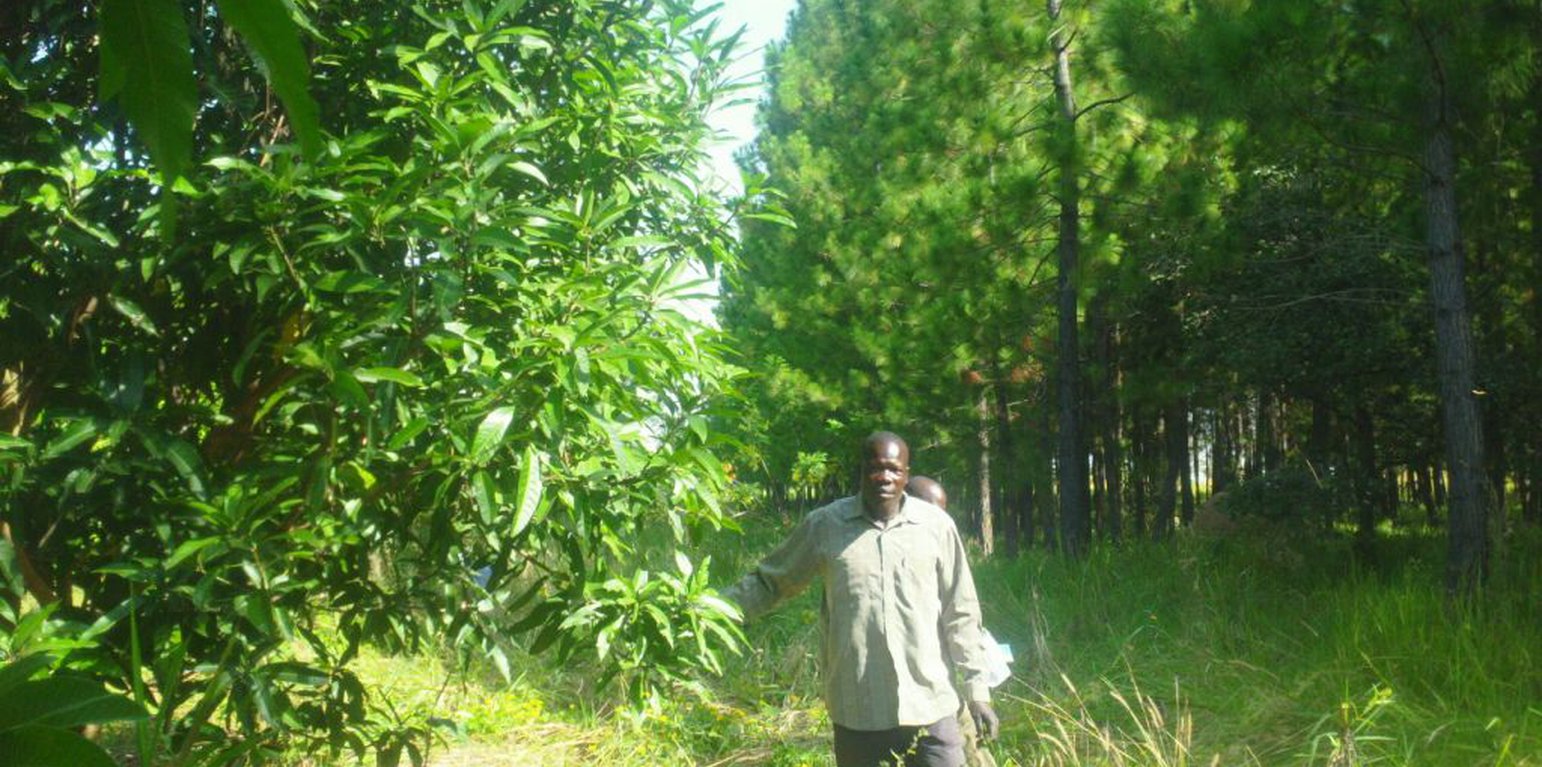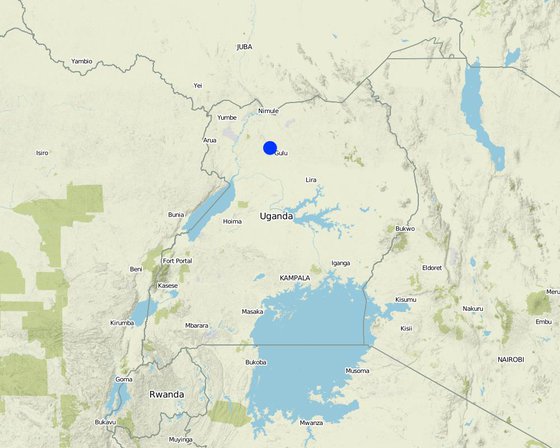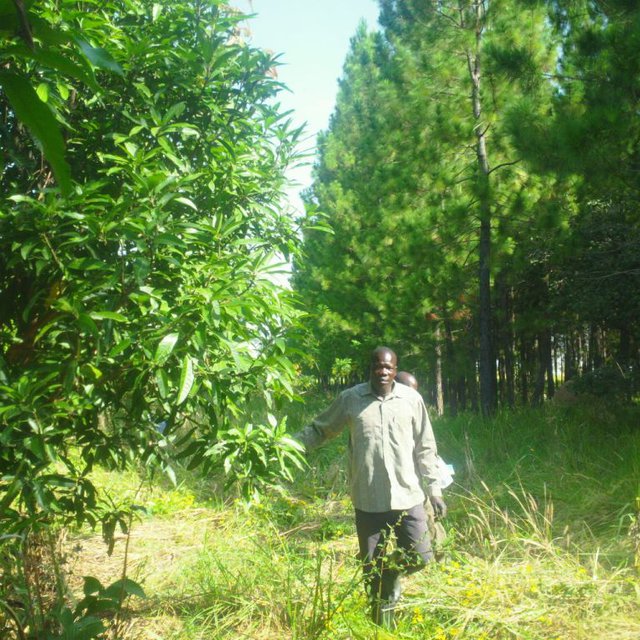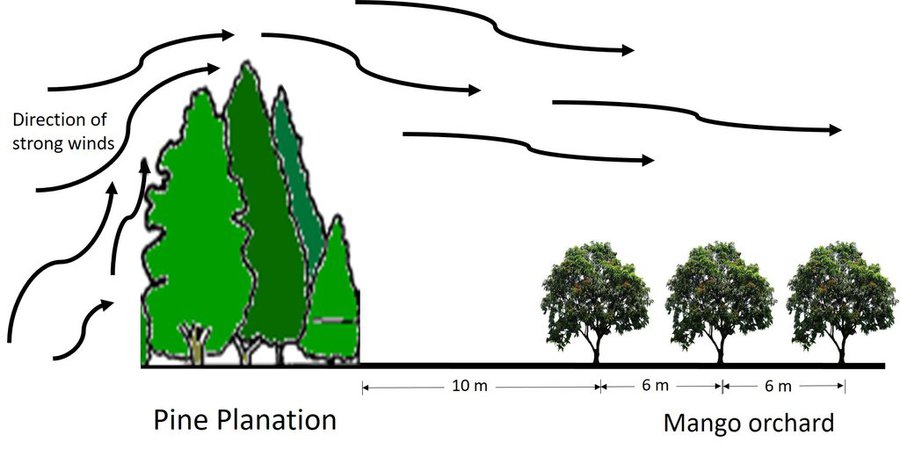



Falling of flower buds and young fruits are brought about by strong winds common in northern Uganda. This can significantly reduce the number of fruits harvested and therefore cause a reduction in income to the farmer.
Fruit trees (mainly mangoes and oranges) are protected from strong winds by establishing a pine plantation beside the orchard. The plantation of pine is established in the direction from where the strong winds come and the fruit trees are established on the opposite side so that the wind velocity is reduced by the pines before it damages the fruit trees. This is because pine trees generally grow taller than the fruit trees and thus provide a shield against strong winds. Individual plants of the fruit trees are planted at a spacing of 6 x 6 m within and between rows. The spacing between the fruit trees and pine trees is approximately 10 meters. Within five years, pine trees reach a size of about 8 meters high and a diameter of about 15 cm. The fruit trees and the pines are established at the same time and all management activities such as weeding, pruning and thinning are done in a manner similar to conventional management practice for individual orchards or pine plantations.
The most important inputs for this technology are the seedlings, labour for planting and periodic activities such as weeding, thinning and pruning. On average, a seedling of a fruit tree costs about UGX 3,000 while a pine tree costs UGX 500. Approximately 500 trees are planted in an acre of land in the ratio of 3:1 for fruit tree to pine tree, respectively. This technology is suitable for farmers who have extra land besides that for the orchards, in order to plant pine shelterbelts.
One great advantage of this technology to farmers is that it provides benefits from both pine plantation and from the orchard. According to the farmer, controlling wind speed using pine shelterbelts can improve the yield of the fruit trees by up to 50% which compensates for the number of fruit trees being reduced by 30%. Nonetheless, the return on investment is high, mainly due to the high price fetched for the fruits from the orchard. This technology is also a climate change adaptation strategy because it guards against extreme weather events such as strong winds, diversifies farmers income and mitigates climate change through carbon sequestration in pine plantation.
Despite the advantages, the farmer was abhorrent of the high establishment costs that are also relatively high compared to the costs a farmer has growing only orchards. The payback period is also fairly long, approaching 5 years for the orchard and 15-20 years for the timber from the pines. A further challenge is how to manage drought and heavy winds that are becoming more frequent and extreme.
Shielding orchards is done where the land is generally flat and the winds are strong such as in the plains of northern Uganda. It is suitable where both fruit trees and timber provide equally important products for the market.

Location: Northern, Uganda
No. of Technology sites analysed: single site
Spread of the Technology: evenly spread over an area (approx. < 0.1 km2 (10 ha))
Date of implementation: 2013; less than 10 years ago (recently)
Type of introduction






Technical specifications
Author: Bernard Fungo
Pine trees spaced at 3 x 3 meters throughout the plantation
Approximately 500 trees per acre Mango trees planted 10 meters away from the Pine trees spacing of mangoes is 6 x 6 meters |
|||||||||||
| Specify input | Unit | Quantity | Costs per Unit (Uganda Shillings) | Total costs per input (Uganda Shillings) | % of costs borne by land users |
| Labour | |||||
| Land preparation | Acre | 1.0 | 200000.0 | 200000.0 | 100.0 |
| Planting | Acre | 1.0 | 100000.0 | 100000.0 | 100.0 |
| Plant material | |||||
| Seedlings of Pine | Acre | 500.0 | 500.0 | 250000.0 | 100.0 |
| Seedlings of Mangoes | Acre | 300.0 | 3000.0 | 900000.0 | 100.0 |
| Total costs for establishment of the Technology | 1'450'000.0 | ||||
| Specify input | Unit | Quantity | Costs per Unit (Uganda Shillings) | Total costs per input (Uganda Shillings) | % of costs borne by land users |
| Labour | |||||
| Weeding | Acre | 1.0 | 100000.0 | 100000.0 | 100.0 |
| Pruning of Pine | Acre | 1.0 | 20000.0 | 20000.0 | 100.0 |
| Thinning of Pine | Acre | 1.0 | 200000.0 | 200000.0 | 100.0 |
| Plant material | |||||
| Seedlings for beating-up - Pine | Number | 100.0 | 500.0 | 50000.0 | 100.0 |
| Seedlings for beating-up - Mangoes | Number | 50.0 | 3000.0 | 150000.0 | 100.0 |
| Total costs for maintenance of the Technology | 520'000.0 | ||||